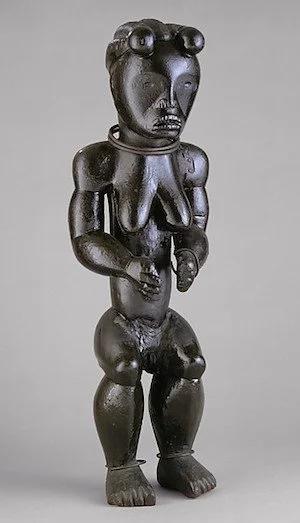Simone Leigh & Suzanne Césaire : the Doudouism concept
Simone Leigh
Born in 1967 to Jamaican parents. She grew up in Chicago, Illinois in a black neighborhood, today she promotes black feminism. Not only is she a great sculpter but she also put philosophical meaning in her work. Her art is deeply steeped in many identity elements from all the African diaspora. In 2022, she was chosen to represent the US at the Biennale of Venice.
Suzanne Césaire
Born in 1915 in Martinique when the island was still considered as a French colony, she studied in Toulouse and Paris, France at the Ecole Normale Supérieure. As a brilliant writer and sociologist, she was part of the Négritude movement and married Aimé Césaire, a major figure of this movement. They founded the journal Tropiques (1941-1945) which shed light on black culture.
“The way you understand a sculpture is by relating it to your own body.”
This article will focus on to what extent black women and particularly Caribbean women can relate to Simone Leigh’s sculptures. The work of Suzanne Césaire which inspired the artist will be our guideline to understand this connection.
The Doudouism concept :
Movement coined by French colons and slave holders in order to keep Caribbean women docile. It is a romanticized and paternalist stereotypes of West Indian women who have to remain warm, seductive and exotic. Suzanne Césaire describes this movement as a feminization of the islands and an illusion of sentimentality. Indeed, it is a destruction and an appropriation of women to maintain a domination relationship between the mainland France and the colonies. In her opinion, this propaganda is a form of refined slavery to keep people under control.
Seated Female, 19th–early 20th century, Fang peoples, Okak group, Gabon or Equatorial Guinea, wood, metal, 64 x 20 x 16.5 cm (The Metropolitan Museum of Art)
Simone Leigh combines African American shapes of the jug, torso that refer to the early 20th century African sculptures and a contemporary representation of women.
By merging women’s bodies and domestic vessels, she conjures up a narrative about black female labour. This is a quintessential connection to doudouism because it links the idea that black women are predetermined to do domestic work. Here, it all connects to slavery and the image given to docile women who could work in houses instead of working in the fields. She criticizes that perspective of women with the postures she gives to her sculptures. Indeed, the African-like torso empower the woman portrayed. In one hand it expresses strength and in the other hand it evokes the notion of roots and origin as a way to find power. Moreover, we can also notice a historical continuum in Leigh’s work. She manages to depict oppression, empowering and today society which finds expression in the contemporary representation of women, with afro hair, unusual colors and without eyes. The fact that she combines this image of a strong black women and doudouism criteria of an “exotic woman” is a critic of women discrimination and alienation. Her work is deeply feminist because she embodies stereotypes in order to redefine it.
From here, we can make a connection with the quote and wonder why we can relate to her sculptures and why is it so relevant. The pan africanist narrative she uses mixing Benin materials, slavery references and African American jugs speak to a large number of persons. Indeed, Leigh thinks of her work as autoethnograpic, which means that it focuses on her self-identity but she also adds some narratives. Here, we understand a sort of duality in her work because it brings about a common reflexion but also a more personal one. For instance, the fact that most of her faces don’t have eyes even though eyes are supposed to be the window of the soul. Not seeing it is a way to desindividualize the character and also a way to see ourselves in the sculpture’s face.
Brick House on the High Line in New York, US.
The sculpture Martinique is very interesting because it encapsulates the connection between Simone Leigh feminism and Suzanne Césaire when she criticized doudouism. First, we can notice that Leigh refers to Césaire because she entitled this work Martinique. However, this is not the only reference, she used the color “bleu outremer” (translated in “ultramarine blue”) as a nod to overseas French territories which are called “ultramarine territories”. Furthermore, the shape of her breast alludes to confidence and maybe the idea of fighting as it was rejecting the sexual and docile perception of woman. The hands seem to hold the breast, either protect it or support it. Here, we can see the notion of being independent, to emancipate but also to embody our femininity and sexuality. The character free itself from the colonial vision and literally embodies its power, she is in control. For Suzanne Césaire, Caribbean people should (in French) “diriger leur regard vers les faims, les peurs, les haine, la férocité qui brûle dans les creux des mornes”/ “look forward the hunger, the fear, the hate, the ferocity which burns in the lands.” We could interpret the posture as an allegory of this quote.
Martinique




